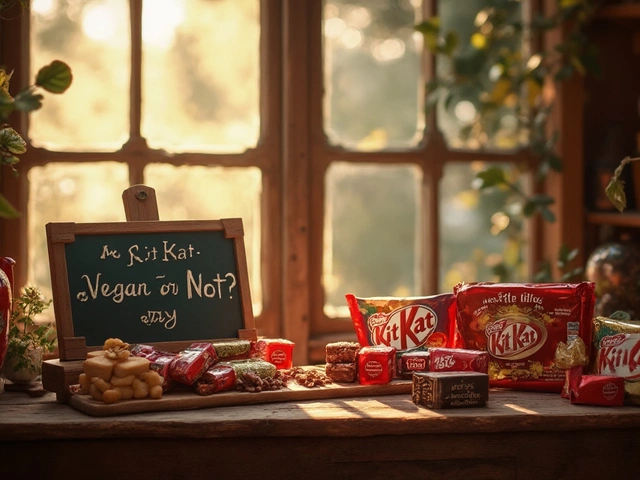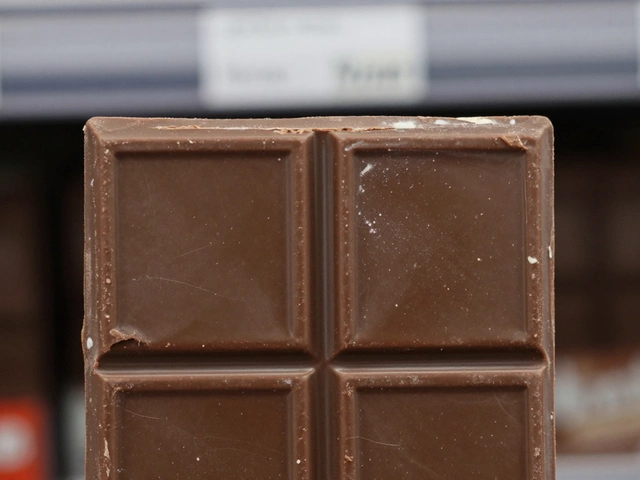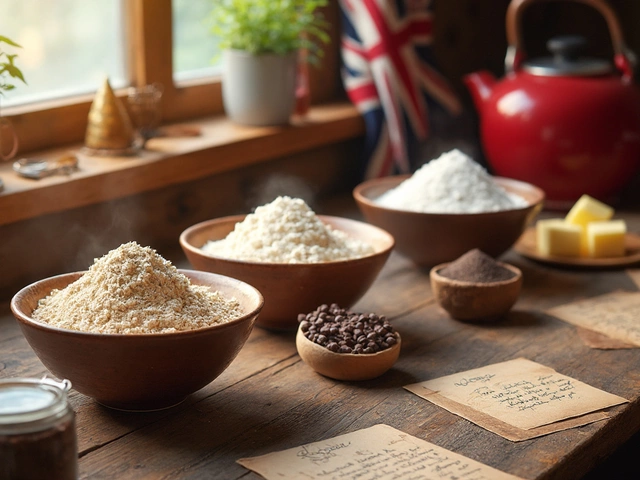
Think that chewy fruit snack or dark chocolate cookie is vegan just because it looks plant-based? Not so fast. Loads of desserts that seem harmless actually sneak in animal stuff—sometimes in the smallest amount, but enough to ruin the vegan badge.
That super glossy frosting on cupcakes might have gelatin from animal bones. Sugar in candy? It could be filtered with bone char, which sounds gross but it’s true. Even marshmallows, which seem pretty innocent, often contain gelatin. And then there’s honey—so many desserts use honey as a sweetener that you just stop noticing.
If you want to actually eat vegan, you’ve got to play detective. It’s not enough to avoid eggs and milk anymore—ingredients like confectioner’s glaze (from bugs!), certain food colorings, and whey powder pop up all over the place. Knowing what to look for helps you sidestep all the hidden stuff, so you can still have your cake (and eat it without fear).
- Desserts That Aren’t as Vegan as They Look
- Sneaky Animal Ingredients in Sweets
- Classic Treats That Mix Up Vegans
- How to Read Dessert Labels Like a Pro
- Easy Vegan Swaps for Dessert Lovers
- Survival Guide: Eating Out and Staying Vegan
Desserts That Aren’t as Vegan as They Look
Some desserts really do a good job of pretending to be vegan-friendly, but if you’re not careful, you can get caught out. Let’s talk specifics—these are popular vegan desserts (or so people think) that pack surprise animal ingredients. You’ve probably snacked on at least one of these thinking it’s safe.
- Gummy candies and marshmallows look plant-based but almost always have gelatin. Gelatin comes straight from animal bones or skin. So even if those candies are cherry-flavored or colored super bright, avoid them unless the package says “vegan.”
- Chocolate chips and dark chocolate bars can seem fine—no milk in sight on the front label, right? But lots of brands add milk fat, whey, or even butter oil. Always scan ingredients, even on semi-sweet or so-called “dairy-free” options.
- Sugar cookies in a store bakery often use eggs and butter. But here’s the kicker: sometimes even the sugar is not vegan, since it can be processed with bone char. This is pretty common in the U.S.
- Pie crusts and pastries might use lard (which is pig fat), especially in fruit pies that you’d assume are dairy-free. It’s not just grandma’s secret crust recipe—tons of pre-made crusts do this.
- Frostings, glazes, and sprinkles can be sneaky too. Confectioner's glaze on sprinkles is made using shellac, which comes from insects. And that perfect glossy cake top? It might be set with gelatin or animal-based glycerin.
To help you spot what might trip you up, check this out:
| Dessert | Common Non-Vegan Ingredient |
|---|---|
| Fruit gummies | Gelatin |
| Chocolate chips | Milk fat, whey |
| Frosted donuts | Confectioner’s glaze, eggs |
| Pie crust | Lard, butter |
| Marshmallows | Gelatin |
There’s no shame in getting fooled—it happens to most people, even seasoned vegans. Just keep your eye out for these non-vegan sweets when you’re filling your dessert plate, and always double-check ingredient lists. That way, sticking to your vegan desserts lifestyle feels a lot less like playing dessert roulette.
Sneaky Animal Ingredients in Sweets
If you're all about vegan desserts, you already know to skip milk and eggs. But dessert shelves are packed with stuff most people don't think about. Take a scan of any candy aisle, and you'll find some kind of animal ingredient hiding in plain sight.
Here's where things get sketchy:
- Gelatin: It’s made from animal bones and skin, tossed everywhere from gummy bears and marshmallows to some cakes and jellies. If you see 'gelatin' on the label, just walk away if you want it truly vegan.
- Confectioner's Glaze: Sounds fancy, but it's made from crushed bugs (lac beetles, to be exact). This shiny stuff shows up on candy shells and glossy dessert toppings.
- Carmine (E120): This bright red dye also comes from bugs. You’ll spot it in red or pink candies, some frostings, and even ice cream swirls.
- Whey and Casein: Both sneak in from dairy, showing up in chocolate, protein bars, and even "non-dairy" creamers for icing or filling.
- Honey: Loads of granola bars, cookies, and even some chocolate bars use honey instead of regular sugar—but it’s not considered vegan by most standards.
- Isinglass: Super rare in sweets, but worth mentioning for jelled desserts and some glazes—it comes from fish bladders.
- Bone Char Sugar: Some cane sugars get filtered using charred animal bones. If you're baking or buying sweet stuff, watch out for "refined sugar" in the U.S.—it might not be vegan unless labeled organic or raw.
| Ingredient | Source | Common Products |
|---|---|---|
| Gelatin | Animals (Bones/Skin) | Marshmallows, Gummies |
| Confectioner's Glaze | Lac Beetles | Candy Coatings |
| Carmine (E120) | Cochineal Bugs | Food Coloring in Desserts |
| Isinglass | Fish Bladders | Some Jellied Sweets |
So next time you grab a non-vegan sweet or eye that mystery glaze on a pastry, remember these ingredients. Even foods labeled as "natural" or "handmade" might use them, especially in imported or old-school recipes.
Classic Treats That Mix Up Vegans
It’s easier to fall for non-vegan vegan desserts than you think. Plenty of snacks and sweets you grew up with or see in bakeries actually hide animal-based stuff. Some desserts even have a confusing label that looks plant-based until you dig deeper. Let’s call out some of the big ones that trip up even experienced vegans.
- Chewy candy: A lot of gummy bears, jellybeans, and fruit snacks have gelatin for that bouncy texture. Gelatin comes from animal bones and skin—big disappointment if you thought your candy was vegan.
- Chocolate chip cookies: You’d guess just chocolate, sugar, and flour, right? But many chips use milk fat. Standard cookie recipes also nearly always sneak in butter or eggs.
- Red velvet cake: Looks innocent, but traditional recipes use buttermilk and cream cheese. The vibrant red color often comes from carmine, which is made from crushed beetles.
- Frosting and glazes: Your donut's shiny glaze might have confectioner’s glaze (shellac from insects) or egg whites for stability.
- Apple pie: Sometimes bakers use butter for the crust, or a shiny egg wash. A few old-school recipes add beef fat (suet) into the crust for flakiness—gross, but true.
Even something simple like fruit sorbet can sneak in honey or use bone-char-processed sugar. It always pays to be suspicious and do a quick ingredient check. A 2022 survey found that nearly 35% of packaged “fruit snacks” in supermarkets were not vegan, mostly because of gelatin or confectioner’s glaze.
| Dessert | Hidden Ingredient | Why Non-Vegan |
|---|---|---|
| Gummy Bears | Gelatin | Animal bones and skin |
| Red Velvet Cake | Carmine, buttermilk | Insects, dairy |
| Marshmallows | Gelatin | Animal collagen |
| Pastry Glaze | Egg wash, shellac | Eggs, insects |
So next time you get a craving for a classic treat, double-check that label. You’ll save yourself a lot of guesswork, and you’ll keep your plant-based promises.

How to Read Dessert Labels Like a Pro
Scanning dessert packaging isn’t just about checking for the word “milk.” There’s a laundry list of stuff that can pop up in vegan desserts (or desserts that claim to be vegan) that is actually anything but.
Start with the obvious animal stuff: eggs, milk, butter, honey, and gelatin. But don’t stop there. Dessert labels can hide animal products behind weird names you wouldn’t expect.
- Gelatin: Made from animal bones and tendons. Shows up in gummies, marshmallows, some frosting, and even pie fillings.
- Carmine (or cochineal): This red food dye comes from crushed beetles. It’s in some red or pink frostings, candy, and even sprinkles.
- Confectioner's glaze: Made from lac bugs. Used to make candy shiny (think jelly beans and some chocolate covered treats).
- Bones in the sugar: Refined white sugar, especially in the US, is often processed with bone char. Not every package will say how it’s processed, so reach for organic or beet sugar if you’re unsure.
- Casein and whey: Both come from milk, but brands sometimes sneak them into cookies, ice creams, and even some protein bars.
- L-cysteine: Often used in baked goods to soften them. Sometimes sourced from duck feathers or even pig hair.
If you want to double-check for sneaky non-vegan bits, take two minutes to Google any ingredient that seems weird. Most vegans eventually get good at spotting what’s up.
Here’s a quick cheat sheet for the most common red flags in dessert labels:
| Ingredient | Why It Matters | Where It Hides |
|---|---|---|
| Gelatin | From animal collagen | Gummies, puddings, frosting |
| Whey/Casein | Milk-based proteins | Chocolate, cookies, some breads |
| Honey | Comes from bees | Granola, bars, cakes |
| Carmine | Color from insects | Candy, colored icings |
| Confectioner's glaze | From lac bugs | Shiny sweets, cake decorations |
One last tip: if a product has the certified vegan logo, you’re pretty much good. Without it, stay alert. Learning these hidden ingredient names will help you actually stick to vegan desserts and skip the nasty surprises.
Easy Vegan Swaps for Dessert Lovers
You don’t have to ditch vegan desserts just because grocery store treats are packed with sneaky animal ingredients. There’s a swap for almost every non-vegan staple, and most of them blend right in with your favorite recipes. Let’s keep things super practical and break down exactly what to use—and why it works.
- Ditch Gelatin: Use agar-agar, which comes from seaweed, to get that same wobbly jelly feel. It sets faster and you only need a little to get results for things like fruit gummies or panna cotta.
- Egg Replacements: Flaxseed meal or chia seeds mixed with water make an eggy gel that’s perfect for baking brownies, cookies, and cakes. For binding, mashed bananas or applesauce work too—just swap 1 egg for 1/4 cup of either one.
- Milk Matters: Soy milk, oat milk, or almond milk stand in for dairy milk in any dessert. They’re about the same consistency and work great in pancakes, rice pudding, or cake batter. Oat milk has a creamy, neutral flavor that blends with almost anything.
- Butter Fix: Plant-based butters or coconut oil give you the fat you need for flaky pie crusts and chewy cookies. If you want that rich flavor, look for vegan butters that use coconut or avocado oils as their base.
- Honey Out: Try maple syrup, agave syrup, or brown rice syrup in recipes calling for honey. Use the same amount and you’ll barely notice the switch.
- Chocolate Caution: Lots of non-dairy chocolates still add milk fat, so double check the label. True vegan dark chocolates usually say "dairy-free" or "vegan." For baking, use cocoa powder plus coconut oil for a homemade chocolate fix.
Check this out—the swap game is catching on. Recent data from a US food industry survey (2024) shows that about 38% of new baking mixes labeled “vegan” use flax or chia as their main egg substitute.
| Common Dessert Ingredient | Vegan Swap |
|---|---|
| Gelatin | Agar-agar |
| Eggs (in baking) | Flaxseed or chia "egg" |
| Dairy milk | Oat/soy/almond milk |
| Butter | Vegan butter or coconut oil |
| Honey | Maple or agave syrup |
| White sugar (sometimes not vegan) | Organic cane sugar or coconut sugar |
You don’t have to learn a bunch of chemistry—just remember these easy vegan swaps and you’ll be baking (and snacking) like a pro in no time. The secret is to check labels, keep your favorite go-to swaps on hand, and experiment a little until you find what works best for your taste. Once you get the hang of it, vegan desserts are even easier than the originals—no hidden surprises, just sweet results.
Survival Guide: Eating Out and Staying Vegan
Eating out as a vegan dessert lover can be a total minefield. It looks simple, but places honestly sneak animal ingredients into all kinds of sweets. Even if the menu says something is "vegan-friendly," don’t blindly trust it—mistakes happen, or sometimes the person in the kitchen just doesn’t know what’s really in the caramel sauce.
So how do you dodge animal stuff and actually enjoy eating out? Here are practical tips to help you out:
- Ask direct questions—Don’t just say, "Is this vegan?" Be specific: "Does your chocolate cake contain eggs, milk, gelatin, honey, or dairy-based glaze?" Servers don’t always realize sneaky stuff like gelatin and confectioner's glaze aren’t vegan.
- Check for fresh fruit—Most restaurants, especially chains, can quickly pull together fruit as a simple, guaranteed vegan dessert. Just double-check there’s no honey drizzle or non-vegan chocolate chips.
- Use online menus—These days, a lot of places post allergen guides online. Spot "contains milk, eggs, or honey" and rule those desserts out fast. You’ll spot hidden animal ingredients way before you even sit down.
- Be cautious with sorbet and gelato—Sorbet might look safe, but honey or dairy sometimes sneak in. Always double-check, even if it’s labeled vegan.
Fast fact: According to a 2024 foodservice survey, around 35% of "vegan" desserts at big chain restaurants still contained animal by-products due to cross-contamination or sneaky ingredients—not great odds.
If you want total peace of mind, a lot of vegans just whip up their own treats and take them along for gatherings or nights out with friends. Not only are your vegan desserts guaranteed safe, but you’ll probably win points for sharing.
Table: Common Dessert Ingredients (and Their Vegan Status)
| Ingredient | Usually Vegan? |
|---|---|
| Gelatin | No |
| Honey | No |
| Confectioner's Glaze | No |
| Soy Milk | Yes |
| Agave Syrup | Yes |
So, don’t get stuck with a sad glass of water at dessert time. Get curious, read those menus, and ask questions. You’ll be surprised at the hidden animal stuff you’ll catch when you really look out for it—and you’ll find safer vegan dessert options, too.











Write a comment